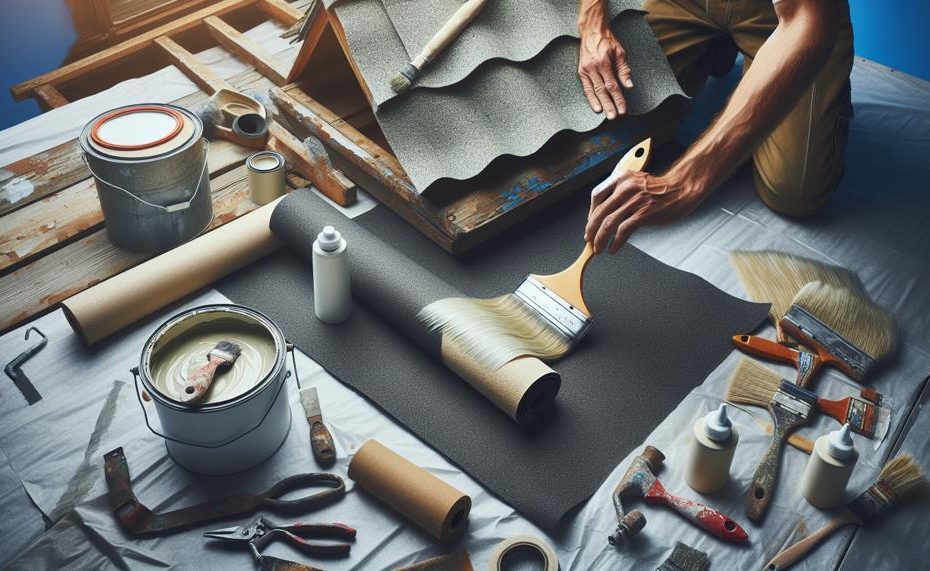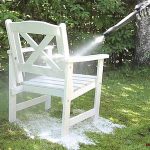Are you tired of the lackluster appearance of your roof?
Want to give your home a fresh new look without breaking the bank? Well, look no further.
Painting roofing felt is a simple and cost-effective way to revamp your roof and enhance the overall aesthetic of your home. Say goodbye to boring roofs and hello to a vibrant, eye-catching addition to your home.
In this blog post, we’ll delve into the world of painting roofing felt and discover how it can transform your roof from drab to fab in no time. Get ready for a step-by-step guide on how to achieve a professional finish, tips for choosing the right paint, and common mistakes to avoid.
Say hello to a stunning roof with this easy DIY project – let’s get started.
Contents
- 1 What Is Roofing Felt?
- 2 Can You Paint Over Roofing Felt?
- 3 Why Is Roofing Felt Important?
- 4 Can You Repair The Roof Felt From The Inside?
- 5 Can You Put Plastic Under The Roof Felt?
- 6 Can You Put A New Roof Felt Over The Old Shed?
- 7 Can Roofing Felt Get Wet?
- 8 Can Roofing Felt Become Porous?
- 9 Can Roofing Felt Be Used Under Hardwood Flooring?
- 10 Conclusion
What Is Roofing Felt?

Roofing felt, also known as tar paper, is a thin and flexible material made from asphalt and either polyester or fiberglass. Its primary function is to serve as an extra layer of protection against water damage and leaks on the roof deck before shingles are installed. Acting as a moisture barrier, it prevents water from seeping through and causing harm.
Not only does roofing felt play a critical role in protecting the roof from water damage, but it also helps prolong its lifespan and prevents expensive repairs. It also contributes to energy efficiency by creating a barrier between the roof and outdoor elements.
Before embarking on an exterior painting project, it is crucial to ensure that the roofing felt is in good condition. If there are any minor damages, they can be easily repaired from the inside using a new piece of felt and sealants. However, painting over damaged roofing felt is not recommended as it could lead to further damage.
When painting over roofing felt, it is essential to use bitumen paint that is specifically designed for this purpose. Bitumen paint forms a protective barrier against the elements and does not require any special equipment for application. This ensures that the paint adheres properly and provides long-lasting protection.
Aside from its role in protecting the roof, roofing felt can also be used as a moisture barrier and noise dampener under hardwood flooring.
Can You Paint Over Roofing Felt?
You may have wondered if it is possible to paint over roofing felt. The answer is yes, but it’s crucial to use the correct type of paint and follow specific steps for optimal results. Here is a detailed guide on how to paint over roofing felt:
- Prepare the Surface: It’s essential to have a clean and dry surface before painting. Use a broom or pressure washer to remove any dirt or debris. If there are any cracks or holes, patch them with bitumen sealant and make sure they are completely dry.
- Choose the Right Paint: It’s crucial to use a strong paint that is specifically designed for roofing felt. Experts and users recommend bitumen paint for its durability and water-resistant properties.
- Prime the Surface: To ensure the paint adheres well to the roofing felt, it’s recommended to use a primer before painting. This will also help seal any remaining cracks or holes.
- Apply the Paint: Use a paintbrush or roller to apply the bitumen paint evenly over the roofing felt. For maximum protection and coverage, it’s recommended to apply at least two coats.
- Add Solar Reflective Paint: Consider adding a couple of coats of solar reflective paint on top of the bitumen paint for added protection and energy efficiency.
- Allow Time to Dry: After painting, it’s important to allow the roof felt to dry completely before walking on it or adding any shingles or other materials on top.
Why Is Roofing Felt Important?
Roofing felt is a crucial element in ensuring the success of any roofing project. Its primary purpose is to serve as a protective barrier between the roof deck and the final roofing material, providing an additional layer of protection against harsh weather conditions.
This thin but essential layer of material plays a vital role in preventing water, wind, and snow from seeping into the roof and causing potential damage. It also serves to keep the roof deck dry during the roofing process, preventing any moisture-related issues.
In addition to its protective function, roofing felt also plays a significant role in creating a smooth and even surface for shingle installation. Without this important underlayment, shingles may not lay flat, resulting in unevenness or gaps in the roof. This can lead to leaks and other structural issues over time. By providing a flat surface for shingle placement, roofing felt ensures a more durable and long-lasting roof.
Roofing felt is essential for improving energy efficiency. When properly installed, it acts as an extra layer of insulation, helping to regulate temperature inside the home by keeping heat in during colder months and out during hotter months. This not only maintains a comfortable temperature inside but also reduces energy costs.
Can You Repair The Roof Felt From The Inside?
The answer is yes, but it may not consistently provide the most effective result. To repair roof felt from the inside, you can place a piece of felt over the hole and use sealants to stop any small drips. Tears and holes can also be mended using bitumen-based adhesive.
Regularly checking and maintaining your roof felt is crucial in preventing potential damage or leaks. In case of tears or holes, repairing them immediately is necessary to avoid further harm to your roof and building interior.
But is it possible to repair roof felt from the inside without accessing the roof itself? Yes, it can be done, but it may not always be the best solution. While this method may work well for smaller or simpler repairs, it may not be as effective for larger or more complex repairs. The best way to ensure a proper and long-lasting repair is by accessing the roof and fixing the felt from both sides.
| Repairing from Inside | Accessing the Roof |
| Can be done quickly and easily | May require more time and effort |
| Works best for minor repairs | Ideal for major repairs |
| May not provide the most effective result | Ensures a proper and long-lasting repair |
| No need for professional assistance | May require professional help |
| Can be a temporary fix until you can access the roof | Provides a permanent solution |
While repairing roof felt from the inside may seem like a convenient solution, it is important to note that it may not always be the most effective method. This is because the underlying damage may not be fully visible or accessible from inside the building.
Accessing the roof allows for a thorough inspection of the damage and ensures a proper and long-lasting repair. It also provides an opportunity to check for any other potential issues that may need addressing.
However, if accessing the roof is not possible, repairing the roof felt from the inside can serve as a temporary fix until you can fully address the issue. Keep in mind that this method may require more frequent checks and repairs to maintain the integrity of your roof.
Can You Put Plastic Under The Roof Felt?
When considering using plastic as an underlayment for roofing felt, it may initially seem like a practical solution, but it is not recommended. This is because plastic does not allow for proper ventilation and can potentially trap moisture, leading to the growth of mold and mildew.
Additionally, plastic is not as durable as other underlayment options and is prone to tearing or puncturing, which can compromise the integrity of the roof.
Therefore, it is crucial to choose a suitable underlayment material that is specifically designed for roofing applications.
| Underlayment Type | Advantages | Disadvantages |
| Synthetic | Durable, water-resistant, lightweight, UV-resistant | Expensive, slippery, potential to trap moisture |
| Felt | Inexpensive, slip-resistant, absorbs moisture | Less durable, less water-resistant, heavier, higher environmental impact |
When deciding between synthetic or felt underlayment, it is essential to consider factors such as budget, climate, and specific project needs. In some cases, roofing manufacturers may recommend or require a particular type of underlayment for their systems. Therefore, it is best to consult with a professional contractor to determine the most suitable option for your project.
Furthermore, using plastic as an underlayment for roofing felt can also have consequences on warranty coverage. Many roofing warranties may become void if materials that are not approved by the manufacturer are used during installation. This can result in costly repairs or replacements in the future.
Can You Put A New Roof Felt Over The Old Shed?
Installing new roof felt over an existing layer on a shed may seem like a quick and cost-effective solution, but it is not recommended. This can result in uneven surfaces, possible leaks, and even void the warranty for your roofing materials. It is always best to consult with a professional and carefully consider all factors before making a decision.
Furthermore, simply adding a new layer of felt over the old one does not address any underlying issues that may be present in the existing roof. Over time, these issues can worsen and lead to more extensive damage and costly repairs.
In fact, opting for a quick fix instead of addressing the root cause of the problem can end up costing you more in the long run. It’s important to thoroughly inspect your roof and address any issues before installing new felt.
Additionally, adding multiple layers of felt can add unnecessary weight to your shed’s roof. This can potentially cause structural damage or even collapse, posing a safety hazard.
To avoid these issues and ensure the longevity of your roof, it is crucial to consult with a professional roofer. They have the expertise and knowledge to properly assess your roof’s condition and make recommendations that will provide long-term solutions.
Can Roofing Felt Get Wet?
Yes, roofing felt can get wet, but it’s not a sponge-like material. Roofing felt is water-resistant, but not waterproof. It’s designed to repel water, not absorb it.
Roofing felt is a thin layer of material made from polyester or fiberglass that goes between a roof’s plywood and shingles. It allows the roof to breathe while repelling water from rain or snow.
Roofing felt can get wet, but it can maintain its integrity if it’s not exposed to other elements for a few days. Exposure to sunlight and more rain can cause it to break down.
Too much water will damage it and impair its ability to keep your roof’s integrity.
Can Roofing Felt Become Porous?
As roofing felt ages, its porosity increases, making it more susceptible to absorbing water and moisture. This can cause damage to the roof structure and increase the risk of leaks and water damage inside the home. The impact of aging is compounded by weathering, particularly from UV radiation, which can break down the material and make it more brittle and prone to cracking and shrinking. This further increases its porosity and diminishes its effectiveness in protecting the roof.
Unfortunately, painting roofing felt does not reverse its porosity. While it may improve the appearance of aged or weathered felt temporarily, it does not restore its original protective properties. In fact, painting over damaged or deteriorated roofing felt can trap moisture underneath, leading to further deterioration and potential mold growth.
Rather than relying on painting as a solution, regular maintenance and repairs are crucial in preventing and slowing down the aging and weathering process.
This includes ensuring proper ventilation to prevent excessive heat buildup, removing debris from the roof surface, and promptly addressing any signs of damage or deterioration.
Can Roofing Felt Be Used Under Hardwood Flooring?
It is not recommended to use roofing felt as an underlayment for hardwood flooring. While it may be a cost-effective option, it can lead to moisture issues that can potentially damage your hardwood flooring.
The National Wood Flooring Association (NWFA) advises using 15-pound or 30-pound felt paper as an underlayment for hardwood flooring in the construction industry.
Roofing felt is vulnerable to water damage as it ages, making it unsuitable for use as an underlayment for hardwood flooring. On the other hand, both 15-pound and 30-pound felt paper are specifically designed to provide protection against moisture, making them the recommended options by the NWFA.
When it comes to installation, both types of felt paper follow a similar process. The only difference is the overlap of seams, with 30-pound felt paper requiring a larger overlap of 4 inches compared to 15-pound felt paper’s 2-inch overlap.
This ensures proper coverage and protection against moisture, which is crucial for maintaining the integrity of hardwood flooring.
Conclusion
In conclusion, painting roofing felt is a cost-effective and simple solution to enhance the appearance of your roof and home. This thin layer of material not only protects against water damage but also contributes to energy efficiency.
However, it is crucial to use the right type of paint and follow proper preparation and application steps for optimal results. Regular maintenance is also important in preventing potential damage or leaks.
While repairing roof felt from the inside may seem like a viable option, accessing the roof itself ensures a proper and long-lasting repair. Avoid using plastic as an underlayment for roofing felt as it lacks durability and can trap moisture, leading to further damage.
Installing new roof felt over an existing layer on a shed may seem like a quick fix, but it can result in uneven surfaces and void warranty coverage. Proper installation and maintenance are crucial as water exposure can greatly impact the effectiveness of roofing felt. As it ages, roofing felt becomes less porous and therefore less effective in protecting your home from water damage.
Lastly, avoid using roofing felt as an underlayment for hardwood flooring as it is susceptible to water damage compared to specifically designed options such as 15-pound or 30-pound felt paper.





